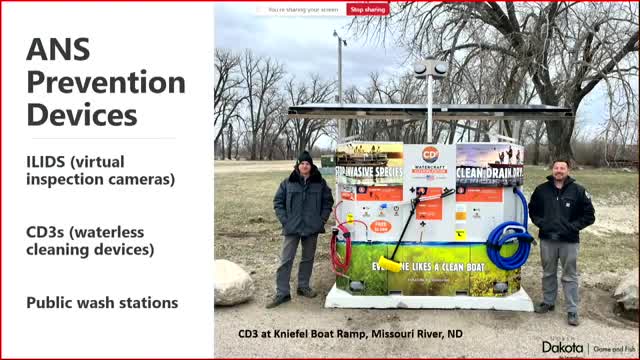Zebra mussel crisis sparks innovative prevention strategies
September 12, 2024 | Fargo , Cass County, North Dakota
This article was created by AI summarizing key points discussed. AI makes mistakes, so for full details and context, please refer to the video of the full meeting. Please report any errors so we can fix them. Report an error »

In a recent government meeting, officials discussed critical measures to combat the spread of zebra mussels in North Dakota's waterways. The meeting highlighted the implementation of innovative tools and public wash stations aimed at educating boat owners on the importance of cleaning, draining, and drying their vessels before leaving water bodies.
One notable initiative presented was the introduction of a CD 3 waterless cleaning device, equipped with various tools such as wet-dry vacuums and air hoses, designed to facilitate the cleaning process for boaters. Public wash stations have been established at key locations, including L'Amour and Jamestown Reservoir, to encourage compliance with these practices, particularly in areas heavily infested with zebra mussels.
The meeting also addressed staffing challenges faced by the department, particularly during the summer months. To mitigate this, officials have begun utilizing virtual inspection cameras at boat ramps. These cameras activate as boats launch, recording footage that is then analyzed remotely. This system not only identifies boats carrying vegetation but also provides real-time guidance to boaters about the necessary steps to prevent the spread of invasive species.
Senator Wilson emphasized the urgency of addressing zebra mussel infestations, particularly at Lake Ashtabula, which has been identified as the most severely affected waterway. The discussion included the potential ecological impacts of zebra mussels, with officials noting that while certain fish species can consume them, they are not effective enough to control their populations.
The meeting concluded with a call for continued preventive measures, as current treatments, such as copper applications, pose risks to other aquatic life and require ongoing management. Officials expressed hope for future advancements in control methods, underscoring the importance of prevention to safeguard North Dakota's waterways and reduce long-term costs associated with invasive species management.
One notable initiative presented was the introduction of a CD 3 waterless cleaning device, equipped with various tools such as wet-dry vacuums and air hoses, designed to facilitate the cleaning process for boaters. Public wash stations have been established at key locations, including L'Amour and Jamestown Reservoir, to encourage compliance with these practices, particularly in areas heavily infested with zebra mussels.
The meeting also addressed staffing challenges faced by the department, particularly during the summer months. To mitigate this, officials have begun utilizing virtual inspection cameras at boat ramps. These cameras activate as boats launch, recording footage that is then analyzed remotely. This system not only identifies boats carrying vegetation but also provides real-time guidance to boaters about the necessary steps to prevent the spread of invasive species.
Senator Wilson emphasized the urgency of addressing zebra mussel infestations, particularly at Lake Ashtabula, which has been identified as the most severely affected waterway. The discussion included the potential ecological impacts of zebra mussels, with officials noting that while certain fish species can consume them, they are not effective enough to control their populations.
The meeting concluded with a call for continued preventive measures, as current treatments, such as copper applications, pose risks to other aquatic life and require ongoing management. Officials expressed hope for future advancements in control methods, underscoring the importance of prevention to safeguard North Dakota's waterways and reduce long-term costs associated with invasive species management.
View full meeting
This article is based on a recent meeting—watch the full video and explore the complete transcript for deeper insights into the discussion.
View full meeting
